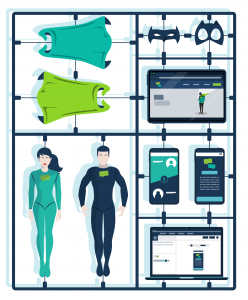In 2023, our L&D trends list looks a lot different than in 2021 and 2022. After all, Covid-19 has been a focal point for individuals and organisations alike.
However, slowly and surely, the world has started to take steps back towards ‘normality’. By the time the clock hit midnight to welcome the new year, our focus had shifted to reflect new world events, industry innovations and fresh research.
Different tools, approaches and strategies fluctuate in popularity throughout the years, just like fashion trends do (who would have guessed UGG boots would make a comeback?).
For example, mobile delivery used to be a hot topic. Now it’s the norm. Similarly, AI was a mildly popular topic a few years back. Now, a new surge in innovation has skyrocketed conversations around it.
Regardless of trends coming and going, one thing is for sure: L&D is as relevant as ever, and new technological advances are helping the industry to thrive.
Without further ado, let’s explore 14 L&D trends we expect to influence the industry in 2023 – spiced up with some chillies to show just how hot the trend is this year!
14 L&D Trends for 2023
1. Artificial Intelligence 🌶️🌶️🌶️
Artificial intelligence (AI) was part of our trends list last year too, but this year, we feel like it deserves the number one spot. After all, it’s undeniable that AI has been on everyone’s lips this year.
This is largely thanks to the free AI tool ChatGPT. It was launched in November 2022 and has remained a hot topic across industries, including learning and development.

Previously, AI has been a somewhat abstract concept. Everyone knew about it, but not many of us had had the opportunity to use AI-driven tools in person.
ChatGPT changed the narrative by giving us concrete examples and new and exciting ways to apply artificial intelligence. This has increased our understanding of the possibilities of AI.
The L&D Global Sentiment Survey, a one-minute survey for L&D professionals of the pulse of the industry, saw a huge growing focus on artificial intelligence, driven by the launch of ChatGPT. AI jumped to number 2 from number 12 last year.
However, Donald H Taylor also discovered that opinions vary widely across countries. For example, South America only ranked AI as number 9, whereas it was number 1 in North and Central America.
2. Data-Driven Learning 🌶️🌶️🌶️
Considering the advances in technology and the swift move to online learning following Covid-19, it makes sense that there is an increased focus on data-driven learning.
After all, tools like learning management systems (LMSs) or learning apps make it increasingly easy to collect, analyse and store data. Similarly, L&D teams can take advantage of increasingly clever algorithms.
For example, these tools are increasingly proficient at diagnosing learning needs, notifying instructors of issues, and recommending content based on learning goals and competency levels.
As such, learning technology is now well placed to help organisations to create personalised training interventions that enable them to meet learners’ unique needs. This, in turn, helps you to increase engagement and create business impact.
Not only can data create effective training programmes, but it also helps you to convince your stakeholders. After all, you can use this data to gain leadership buy-in or support for your business proposals.
Considering the popularity of both AI and a data-driven approach, it’s clear that L&D folks now have a better understanding of how data can be used to refine their training programmes.
3. Reskilling & Upskilling 🌶️🌶️

Despite the focus on AI and data-driven approaches, there is still a need for upskilling and reskilling.
In fact, companies are going to face a growing skills gap after adopting new technologies or AI-driven strategies. As such, upskilling and reskilling will continue to be a priority as organisations need to address these emerging technical skills shortages.
Upskilling and reskilling enable learners to learn new skills, update their competencies, and take on new responsibilities. This, in turn, helps organisations to remain competitive.
This explains why upskilling and reskilling is still number one on the L&D Global Sentiment Survey, for the third year in a row.
4. Skills-Based Learning 🌶️🌶️
Skills-based learning focuses on providing learners with the skills they need to operate in today’s changing markets. It’s a way to prepare learners for the future.
Learners can take their knowledge up a notch by putting this new information into practice. And as the 70:20:10 model of learning suggests, we learn a whopping 70% simply by doing and experiencing.
This alone makes skills-based learning one of the most important L&D trends in 2023. After all, the demand for skilled professionals has never been higher. What’s more, learners themselves want to learn skills that will improve their performance or future career prospects.
Luckily, today’s modern learning platforms enable L&D professionals to deliver skills-based training interventions more effortlessly than ever before. As such, skills-based learning is a win-win situation for learners, L&D professionals and organisations!
5. Learning On-Demand 🌶️🌶️
We also expect on-demand learning to move from a nice-to-have to an essential training delivery method in 2023. In fact, it’s a must for any organisation that wants to thrive in increasingly competitive markets.
Asynchronous, on-demand learning means a strategy where learners are allowed to explore training content and courses at their own pace. This is guaranteed to improve accessibility as learners can educate themselves at the point of need, regardless of their physical location.
Technology, like learning apps, has made on-demand training easier than before. As technology advances, this kind of asynchronous learning is guaranteed to have a set place in corporate training. In fact, it’s already happening today.
After all, by allowing learners to take authority over their learning, organisations can provide personalised training interventions. This is useful as most organisations need to cater to various roles and training needs.
This is an important step forward. After all, instructor-led training sessions exist in a particular moment in time. However, with an on-demand learning environment, you’ve got a library of evergreen content to share with your audience.
6. Extended Reality Training 🌶️🌶️

Similarly to AI, we see extended reality (XR) in training as one of the hottest L&D trends for 2023. After all, we have seen it grow in popularity year by year.
Extended reality is an umbrella term that covers virtual reality (VR), augmented reality (AR), and mixed reality (MR). These immersive technologies come with a bounty of benefits, but the main takeaway is that these tools have the power to make training interventions more interactive and engaging.
On top of these engagement perks, XR makes it easier to provide hands-on training on practical topics. These topics would typically eat up vast amounts of resources in a non-digital training environment.
Similarly, it enables you to provide safe training for potentially risky or dangerous jobs. For instance, learners can use XR to learn about aviation, medical procedures or how to operate heavy equipment.
The vast applications of extended reality in training is the reason behind its skyrocketing popularity. As a result, we expect XR to stay amongst the popular L&D trends well beyond 2023.
7. Continuous Learning Culture 🌶️🌶️
In 2022, we became familiar with the concept of ‘quiet quitting’. This is a phenomenon where employees are not outright quitting their jobs but do just the bare minimum at work.
In fact, according to a Gallup poll, 50% of workers in the US are considered ‘quiet quitters’. The biggest issue is with employees born after 1989. These employees are millennials or Gen Z who grew up with technology.
In fact, this globally-connected workforce is used to having instant information at their fingertips. Your employees see examples and real-life stories everywhere on social media, including examples of thriving or toxic work environments.
As a result, they are unlikely to put in longer hours or push themselves for a job if it doesn’t give enough in return. This is one of the driving forces behind quiet quitting. It’s also a compelling argument for creating a thriving learning culture.
By creating a continuous learning culture, you can show your employees that you value them, their desires and their career aspirations. An optimised learning strategy gives your learners a reason to stick around for longer. It also generates a sense of belonging, which carries its own motivational force.
8. Results-Driven Training Programmes 🌶️🌶️
While business impact seems an obvious aim for every training programme, results-driven learning earns a spot on our list. After all, gaining and showing business value has been at the centre of L&D discussions for the last few years.
The potential upcoming recession and tightening budgets are a big worry for L&D teams around the world. After all, learning and development is often the first department to suffer from budget cuts.
However, there is a reason why organisations continue to invest in L&D. They want their training programmes to impact the organisation in areas that matter the most.
Based on this, in 2023, L&D teams will focus on creating learning opportunities that drive results. This will see them try to make a positive impact on their organisation’s revenue, value, cost-efficiency or risk mitigation approaches.
9. Social Learning 🌶️
At the height of Covid-19, it was clear that we craved social connections and also placed a bigger emphasis on social learning. After all, these social interactions were few and far between.
Unsurprisingly, collaborative/social learning was rated as number 3 in 2020 and number 2 in both the 2021 and 2022 L&D Global Sentiment Surveys. We, too, rated social learning as one of the biggest L&D trends for both 2021 (2) and 2022 (3).
However, things look a lot different this year. For example, social learning has dropped to the 5th spot in this year’s L&D Global Sentiment Survey. As such, it’s safe to say that our pandemic-related desire for social learning has diminished.
Despite this, social learning is a critical element of successful training programmes. After all, a knowledge-sharing culture comes with endless benefits! This is the reason why social learning continues to be a part of our L&D trends list in 2023.
Social learning has become an essential part of the online learning industry. In fact, social learning features are now a must-have in learning technology as organisations have realised its link to learner engagement and improved performance.
10. Combining In-House and External Content 🌶️

Traditionally, L&D teams either choose to produce their content in-house or purchase externally created training materials. It’s often been a case of either / or.
But in 2023, things are different. It’s no longer acceptable to not provide necessary training simply because you don’t have the right content at your fingertips.
After all, your employees won’t be satisfied with low-quality content or generic, irrelevant training units. As such, we expect organisations to leverage both in-house and external content. These two sources will work in harmony to produce better results for L&D teams.
In fact, high-quality content is more important than ever. Combining in-house and external content ensures organisations can effectively meet their learners’ needs.
11. DEI Training 🌶️
Diversity, equity and inclusion, together referred to as DEI, are terms we hear more and more. In fact, keeping DEI at the forefront of the mind ensures organisations can recruit and retain top talent and compete more successfully.
As such, creating a diverse and inclusive workplace is essential. But that alone is not enough. Organisations also need to integrate DEI into their learning and development efforts.
In 2023, we expect DEI training to become more important than ever. This includes, for example, redesigning hiring and onboarding processes, bringing the DEI lens to skills training and providing mentoring opportunities.
However, DEI is not just about ethnic or racial minorities. The key is to create strategies that will benefit a large number of employees.
This includes employees with disabilities, learners in different age groups, employees of varying genders, gender identities or sexual orientations, learners whose first language isn’t English (or another primary language of your training programme) or employees with different physical or mental limitations.
As a result, organisations can create a workforce who are real-world-ready. Furthermore, they will understand cultural sensitivity and drive better results.
12. Personalised Learning 🌶️

Every person is different. After all, our brains are as distinctive as our fingerprints, and they evolve constantly. This is behind the concept of ‘brain plasticity‘.
When we learn or experience new things, groups of neurons link together creating electrochemical pathways between each other. As such, our brains are literally shaped by our personal needs, interests and experiences.
Organisations have finally realised that personalisation plays a big role in allowing new information to reach the right areas of the brain. In a nutshell, personalised training interventions enable you to store new information more effectively by making it more relevant and memorable.
As such, we expect personalised learning experiences to become the norm in 2023. Learning technology solutions, as well as innovations like AI, will make this easier than ever.
After all, they help you to provide learners with personalised learning pathways that are both relevant and engaging.
13. Leadership Training 🌶️
There is a saying ’employees leave managers, not companies’, and it holds some truth. In fact, 57% have left or would leave their jobs because of a bad boss.
Losing an employee not only costs money but eats up resources and often causes downtime. After all, you need to train new starters until they are up to speed. And this brings us to one of the big L&D trends for 2023.
To help reduce employee turnover and improve performance, organisations are increasingly focusing on leadership training. After all, strong leadership is at the core of every organisation. They optimise the employee experience and create a safe working environment.
Similarly, skilled leaders are better able to tackle the previously mentioned ‘quiet quitting’ challenges. As such, in 2023, we will witness organisations focusing on supercharging their leadership training programmes.
14. Repurposed Content 🌶️
As we mentioned previously, on-demand learning is gaining ground. While this is an extremely useful training method, it also means that you need to create training materials on a wide variety of topics and to suit any number of needs.
The rise of on-demand and personalised learning is why we expect organisations to focus on repurposing their training content in 2023.
Repurposing is a great way to meet wider learner needs without having to stretch your resources. For instance, you can cut your training material into smaller chunks and use different formats.
Similarly, organisations are increasingly taking advantage of and repurposing their learners’ knowledge and experience. In fact, user-generated content (UGC) is a great way to expand your content offering.
Final Words
Over the years, the L&D field has witnessed the emergence of several trends. These trends tend to rise and fall in popularity. However, they have proven effective in improving learning experiences and promoting knowledge retention and application.
Furthermore, the industry continues to evolve, and new innovations are constantly being introduced. These innovations have the potential to reshape the industry and provide even more effective solutions to L&D challenges.
As such, it’s safe to say that 2023 is set to be an exciting year for professionals in the L&D industry! After all, the field is poised for significant growth and innovation.
L&D professionals who stay up-to-date with the latest trends and leverage them to create engaging learning experiences will future proof their approach. After all, they’ll be well positioned to drive success for their organisations and learners alike.
Would you like to learn more about instructing successful training programmes that result in business impact? Then click the link below!









